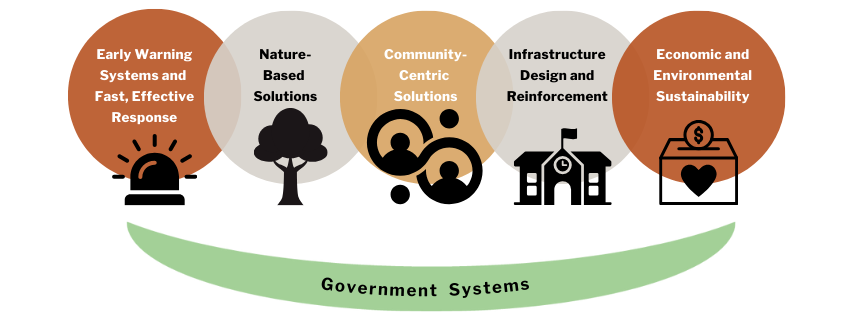On January 3, 2024 Governor Phil Scott and Treasurer Mike Pieciak announced a joint effort to develop a comprehensive Resilience Implementation Strategy by July 1, 2025. The Strategy will build off the considerable work done to date across State Government to identify and prioritize climate resilience needs and evaluate the sufficiency of currently available funding. The Strategy will incorporate extensive stakeholder engagement and will also recommend criteria for allocating state support for climate change resilience projects and approaches for funding implementation efforts on an on-going basis.

The Resilience Implementation Strategy includes six components, which group and build off considerable work done to date to make Vermont more resilient in the face of climate change. One overarching component – Government Systems – encompasses foundational activities that will connect and strengthen resilience strategies across the other five components.
Vision for a Climate Resilient Vermont
Why is a vision important, and how will it be used?
Developing a shared vision is an important first step towards increased resilience to the impacts of climate change in Vermont. Crafting a vision for a resilient Vermont expresses our aspirations and values, focusing on how the things we love most can help us be more resilient to the impacts of climate change. It helps us learn from the negative impacts and build towards the positive changes we’d like to see in Vermont that help us be more prepared and bounce back faster.
The vision guides the Resilience Implementation Strategy by aligning public input and priorities to enhance coordination and impact of state government.
How was the vision written?
This vision was shaped by feedback and input from Vermonters. This input came from engagement conducted by the Climate Action Office, and by state and non-profit organizations over the past five years. The Climate Action Office selected reports based on their relevance to climate resilience issues, inclusion of direct input from Vermonters, and representation of diverse sectors and communities. Comments from those reports were categorized by theme and used to develop an inclusive and comprehensive draft vision. A survey then asked for additional feedback on the vision, and revisions were made.
The intention is to center the work of community partners, reflect the wide range of topics and ideas connected to climate resilience, and ultimately create a vision that is inclusive of various lived experiences and interests.
Steering Committee
The RIS is coordinated by the Agency of Natural Resources’ Climate Action Office with support from a Steering Committee made up of representatives from:
- Agency of Natural Resources (Department of Fish & Wildlife, Department of Environmental Conservation, Department of Forests, Parks and Recreation)
- Public Service Department
- Department of Health
- Vermont Emergency Management
- Agency of Agriculture, Food, and Markets
- State Recovery Office
- Agency of Transportation
- Agency of Commerce and Community Development
- State Treasurer's Office
- and the Vermont State Climatologist.
Engagement
Kick-Off Events
Vermont's Climate Action Office and the Office of the Vermont State Treasurer hosted two public meetings in April 2024 to kick off the development of the state's Resilience Implementation Strategy. The events were attended by more than 120 Vermonters. Interactive exercises and small group conversations captured participants' views and thoughts about how to make Vermont more resilient to the impacts of climate change. Recordings and summaries can be found below:
April 22, 2024 Event Recording
April 25, 2024 Event Recording
Resilience Implementation Strategy Kick-off Presentation Slides
"What does resilience mean to you?" Poll Results
